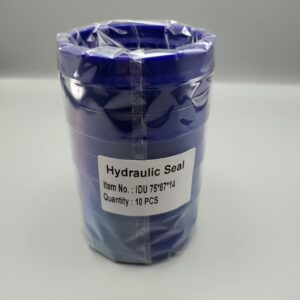Table of Contents
ToggleWhat is a Hydraulic Seal?
A hydraulic seal is a critical component in hydraulic systems, designed to prevent leakage of pressurized fluids, maintain system efficiency, and protect against contamination. These seals create a secure barrier between moving or stationary parts, ensuring hydraulic systems can reliably convert fluid power into mechanical motion. Below is a comprehensive exploration of their functions, types, materials, applications, and maintenance requirements.



1. Definition and Core Functions
What is a Hydraulic Seal?
A hydraulic seal is a non-metallic, flexible component—often shaped as a ring—made from materials like rubber, polyurethane, or PTFE. It is installed in machined grooves or assemblies to block unintended fluid pathways. By sealing gaps between components, hydraulic seals perform four essential roles:
- Contain Fluid
Prevent hydraulic fluid from escaping the system, ensuring consistent pressure for operations like lifting, pushing, or rotating. - Exclude Contaminants
Block external particles (dirt, dust, moisture) from entering the system, which could damage precision components. - Separate Media
Isolate incompatible fluids (e.g., oil and water) in multi-chamber systems. - Facilitate Motion Control
Enable precise conversion of hydraulic pressure into linear or rotary motion while minimizing friction.
Example: In excavators, hydraulic seals keep fluid contained under extreme pressures, allowing booms and buckets to operate smoothly.
2. Classification of Hydraulic Seals
Hydraulic seals are categorized by their application and motion type:
A. Static Seals
Used where no relative motion exists between sealing surfaces. They rely on compression for sealing:
- O-Rings: Circular elastomeric seals for stationary joints (e.g., pipe flanges).
- Gaskets/Flange Seals: Flat seals for bolted connections between fixed components.
- IDI/ODI Seals: Inner/outer diameter seals for fixed gaps in housings.
Design Tip: Static seals require precise groove dimensions and surface finishes to ensure compression.
B. Dynamic Seals
Designed for applications with relative motion between parts. Subtypes include:
i. Rod Seals
- Primary Function: Prevent fluid leakage along reciprocating rods.
- Examples:
- UN Oil Seal: A universal rod seal for moderate-pressure systems.
- DHS (Double Hydraulic Seal): Heavy-duty design for high-pressure cylinders.
- UHS (Ultra High-Speed Seal): Optimized for rapid reciprocating motion.
ii. Piston Seals
- Primary Function: Seal the piston-cylinder gap to maintain pressure differentials.
- Examples:
- LBH (Low Breakout Force Seals): Minimize friction during piston startup.
- SPGO (Step Cut Piston Seal): High-pressure sealing with stepped geometry.
iii. Wiper/Scraper Seals
- Primary Function: Remove contaminants from rods during retraction.
- Examples:
- KDAS (Contaminant Exclusion Seal): Dual-lipped design for debris removal.
- DLI (Dual-Lip Wiper): Combines wiping and secondary sealing.
iv. Rotary Seals
- Primary Function: Seal rotating shafts in pumps, motors, or gearboxes.
- Examples:
- HBT (Heavy-Duty Rotary Seal): For high-torque, high-speed applications.
- JA/FA (Journal/Flange Arrangement Seal): Used in rotating machinery.
3. Material Selection and Design Considerations
Key Materials
The choice of material depends on operational demands:
- Nitrile (Buna-N): Cost-effective, oil-resistant elastomer for general use (e.g., UN, DLI seals).
- Polyurethane: High abrasion resistance, ideal for dynamic seals in high-pressure systems (e.g., LBH, SPGO).
- PTFE (Teflon): Low-friction, chemical-resistant material for extreme temperatures (e.g., HBT seals).
- Fluorocarbon (Viton): Resists aggressive fluids and high heat.
Design Factors
- Pressure Resistance: Seals must withstand system pressure without extrusion (e.g., SPGO for 5,000+ psi).
- Temperature Range: Materials must retain elasticity across operating temperatures (-40°C to 200°C).
- Fluid Compatibility: Avoid chemical degradation from hydraulic oils, synthetics, or water-glycol fluids.
- Motion Type: Reciprocating, rotary, or oscillatory motion demands tailored designs (e.g., UHS for speed).
- Surface Finish: Smooth mating surfaces (Ra ≤ 0.4 µm) reduce wear and leakage risks.
4. Applications Across Industries
Hydraulic seals are indispensable in:
- Construction Equipment: Excavators, cranes, and bulldozers use rod and piston seals in hydraulic cylinders.
- Industrial Machinery: Injection molders and presses rely on rotary seals for pumps and motors.
- Automotive Systems: Brakes and power steering utilize compact dynamic seals.
- Aerospace/Marine: High-performance seals endure extreme conditions in landing gear or steering systems.
- Renewable Energy: Wind turbine pitch controls use seals resistant to pressure fluctuations.
5. Maintenance and Selection Best Practices
Critical Maintenance Steps
- Regular Inspections: Check for wear, cracks, or extrusion in seals.
- Timely Replacement: Swap degraded seals to prevent system failure.
- Proper Installation: Avoid twists or over-compression during fitting.
Selection Guidelines
- Match seal type to motion (e.g., UHS for high-speed rods).
- Choose materials compatible with fluid and temperature (e.g., PTFE for corrosive fluids).
- Prioritize designs with secondary lips (e.g., KDAS) in dusty environments.
Conclusion
A hydraulic seal is a precision-engineered component vital to the performance and longevity of hydraulic systems. Whether static or dynamic, its role in fluid containment, contamination exclusion, and motion control cannot be overstated. Specialized designs like UN, DHS, and KDAS seals address unique operational challenges, from high-speed reciprocation to heavy debris environments. By aligning material properties, geometric features, and maintenance practices with system requirements, engineers ensure optimal reliability and efficiency. Understanding these principles empowers industries to harness hydraulic power safely and effectively across countless applications.



Leave A Comment